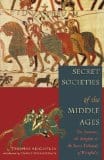
Secret Societies of the Middle Ages: The Assassins, the Templars & the Secret Tribunals of Westphalia
, by Thomas Keightley, introduction by James Wasserman
Red Wheel/Weiser, 1578633346, 432 pp., 2005
First published in 1837 by Thomas Keightley (1789-1872) – and anonymously at that – this book represents one of the earliest working in the English language to examine both the Assassins and the Knights Templar; their foundations and missions; as well as their interactions with their larger societies. With a short introduction by James Wasserman, himself an author on the same topic, this book offers insight into a little understood time in the history of relationships between the Muslim and Christian worlds. This seems especially relevant in today’s post-September 11th world.
As a result of the “War on Terrorism” in the U.S. we have been exposed to a great deal of propaganda regarding Islam. One consequence of that exposure may have a detriment to those reading this book. Over the past 168 years spellings of words coming out of that region have changed. Thus the author refers to Musulmans (Muslims) of the Soonee (Sunni) and Sheah (Shi’ite) branches, and makes reference to mosks (mosques) and the Kalif (caliph). It takes some time to get used to these archaic spellings, but if you persist it becomes easier.
His portrayal in the first part of the book, of the Assassins, is one of the earliest in the English language. It is, for the most part, an apparently even-handed (if not particularly sympathetic) exposition of the known and suspected facts regarding this organization over the course of its existence.
The author displays an anti-Catholic bias during the treatment of the Knights Templar. His portrayal of the Knights is reasonably sympathetic, but his disdain for the Roman Catholic Church, its religious orders (which opposed the organization of the Knights Templar), and the Papacy in particular clearly shows his attitude.
Both of these organizations have been explored in far greater detail during the intervening years, but this book broke important ground at the time it was published. The third organization dealt with in this book (the Secret Tribunals of Westphalia) was completely known to me before I read this book. Although the closest to the current era, it is the least well documented, and receives less space.
Considering the title of the book (Secret Societies of the Middle Ages) I can understand the inclusion of all of these groups, although on other grounds (the sheer secular basis) the Secret Tribunals seems a bit out of place. There were no secret doctrines involved in the Tribunals, although their membership and procedures were hidden from the common man.
I’m not sure what I was expecting before actually opening the covers of this book, but I found myself being pleasantly educated. The writing was not entertaining, but it was easy to comprehend. In spite of the frequency of foreign names (especially in the section dealing with the Assassins) every effort has been made to place them in easily understood formats.
If you are interested in any of these three organizations (and interest in the Templars seems to be fairly constant), this is an excellent introductory work. You will undoubtedly want to pursue further researches but, unless you have access to older books in German and French, this book is the earliest available resource. It is definitely a worthwhile addition to your library








